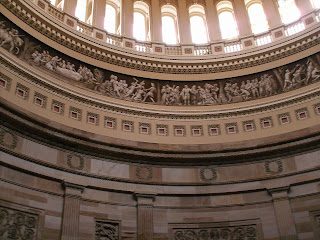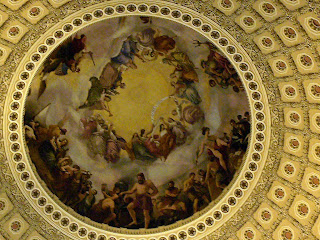My ankles have not quite recovered from walking all over D.C. Someone I knew in California had enormous feet problems from working in a warehouse-style office equipment store, because I was walking on concrete all day. Now I know why.
In a previous posting, I showed some pictures of the U.S. Capitol. I have always wanted to go on a tour, but you have to make reservations well in advance, so I have never done so. But if you get there early enough, you can line up and hope to get in for what is usually described as a limited number of day passes.
So that's what I did. I showed up in line about 8:00 AM. In front of me was a bunch of eighth graders from somewhere in Illinois (or so I gathered from the school affiliated T-shirts that they were wearing). They actually had reservations; it turns out that the rest of us were in line to find out if anyone with reservations did not show. If that was the case, we would get in at their reserved time. Being there at the front of the line really helps.
While standing in line, I struck up a conservation with a father, mother, and daughter from the Burgundy region of France. They were here to sightsee in D.C., Philadelphia, and New York City. (This seems like an extraordinarily limited vacation to America, but perhaps they were on a tight schedule.) He spoke English pretty well, and for the most part he understood me, especially if I spoke slowly and distinctly. Sometimes I would have to pick simpler words. The wife understood English better, and I think the daughter, who was about 18 or 19, understood best of all, but seemed reluctant to speak. (I know that I am reluctant to speak German, because I'm self-conscious about my lack of fluency.) This seemed to be mostly an accent problem; written English seemed to not be much of a problem at all, and the father indicated that they had an easier time understanding British spoken English. I explained that I have had problems sometimes understanding Texans, so this was not a surprise.
The outside of the U.S. Capitol is pretty impressive, in a Roman Republic sort of way. The interior of the Capitol is absolutely beautiful. I was shooting pictures with my HP Photosmart E427, so many pictures did not come out as well as I had hoped. (The camera can go as fast as ISO 400, but it is clumsy to change the speed, and I stupidly forgot to do so.)
I guess that you will not be surprised to find that very little of the history of the building that our tour guide told us about was new to me. But there were still a few discoveries, along the way. In the center of the rotunda is this rather ornate square set in the floor. This is apparently the center of Washington, with all the quadrants (NW, NE, SW, NE) relative to this spot.
Apparently, the original goal was to bury George Washington under this, rather like St. Peter is reputedly buried under the Vatican (and there is some archaeological evidence to back that up).
Looking up, these pictures do not do justice to the beauty of the interior of the dome:
The painting at the very top of the dome almost makes me want to laugh--it's kind of a Sistine Chapel representation of George Washington's divine selection:
Also in the rotunda each state gets to select who to display.
And yes, on the left of the door is California's bronze representative, Ronald Reagan (shockingly enough), and on the right is Kansas's choice, Dwight D. Eisenhower.
There are, of course, plenty of patriotic paintings, such as this Jonathan Trumbull painting of the signing of the Declaration of Independence:
and Robert Weir's Embarkation of the Pilgrims (1843):
You can get a much clearer picture of it here, but there's something so diverse about the crowd in front of the painting that really goes well with the content, don't you agree? As the tour kept emphasizing: E Pluribus Unum: One out of many.
In the hall of statuary there are some surprising choices. Jefferson Davis, for example, from Mississippi. How many countries have a statute of a traitor on display? Louisiana sent a statute of Huey Long--which makes Jefferson Davis seem almost okay. Davis was a traitor, but genuinely believed that he was in rebellion against an oppressive system; Huey Long was just a remarkably crooked politician, and a Democrat (but I repeat myself).








No comments:
Post a Comment